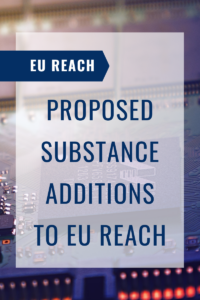EU REACH
September 10, 2024 | Written by GreenSoft Technology, Inc.
ECHA Seeking Comments on Proposed Additions to EU REACH SVHC List and Annex XVII
 Six substances proposed to be added to EU REACH SVHC Candidate List
Six substances proposed to be added to EU REACH SVHC Candidate List
On August 30, the European Chemicals Agency (ECHA) launched a public consultation period on a proposal to add six new substances to the Substances of Very High Concern (SVHC) Candidate List under the EU REACH Regulation. If approved, the change would bring the SVHC Candidate list up to 247 entries.
The 6 proposed substances, as well as their reasons for proposal and common uses, are listed in the table below. Interested parties have until October 14, 2024 to submit comments and further information related to uses, volumes per use, exposure, alternatives and risks of the substance.
The EU REACH SVHC Candidate List currently has 241 entries. However, some entries are groups of chemicals, so the overall number of impacted chemicals is higher.
The inclusion of substances in the EU REACH SVHC List brings immediate obligations for affected companies using the substances in their products above the stated threshold, including customer notification requirements and notifying ECHA through submissions to the SCIP Database. GreenSoft Technology can help with this EU REACH reporting process as part of our Data Services.
The 6 proposed substances are:
|
Substance Name |
EC Number |
CAS Number |
Reason for Proposing |
Examples of use(s) in Electronics |
|
6-[(C10-C13)-alkyl-(branched, unsaturated)-2,5-dioxopyrrolidin-1-yl]hexanoic acid |
701-118-1 |
2156592-54-8 |
Toxic for reproduction (Article 57c) |
Used for surface treatments and adhesion promotion in polymer-based components |
|
O,O,O-triphenyl phosphorothioate |
209-909-9 |
597-82-0 |
PBT (Article 57d) |
Used as a flame retardant additive in polymeric materials to enhance their fire resistance. |
|
Octamethyltrisiloxane |
203-497-4 |
107-51-7 |
vPvB (Article 57e) |
Used as a silicone-based compound for coating and waterproofing, providing protection against moisture and improving the durability of components. |
|
Perfluamine |
206-420-2 |
338-83-0 |
vPvB (Article 57e) |
Used as a fluorinated surfactant or solvent, offering properties like low surface tension, chemical stability, and thermal resistance, often for cleaning or surface treatment applications. |
|
Reaction mass of: triphenylthiophosphate and tertiary butylated phenyl derivatives |
421-820-9 |
192268-65-8 |
PBT (Article 57d) |
Used as an antioxidant and flame retardant additive to improve the stability and fire resistance of polymers and other materials. |
|
Tris(4-nonylphenyl, branched and linear) phosphite |
- |
- |
Endocrine disrupting properties (Article 57(f) – environment) |
Used as a stabilizer and antioxidant, protecting polymers and other materials from degradation due to heat and oxidation during processing and use. |
ECHA’s announcement of the proposals can be found here. The full SVHC-241 list can be found here. The last prior addition to the SVHC list was SVHC-241 in June 2024.
Two substances proposed to be added to EU REACH Annex XVII Restricted Substance List
Additionally, on July 30, the European Commission submitted a draft amendment to add new restrictions under Annex XVII of EU REACH:
- Dimethylacetamide (DMAC); CAS-No. 127- 19-5; EC-No. 204-826-4
- 1-ethyl-2-pyrrolidinon (NEP); CAS-No. 2687-91-4; EC-No. 220-250-6
Dimethylacetamide (DMAC) is typically used in electronics as a solvent for the production of polyimide films, coatings, and adhesives, as well as for cleaning and processing semiconductor materials.
1-Ethyl-2-pyrrolidinone (NEP) is typically used in electronics as a high-performance solvent for resins, coatings, and photoresists in semiconductor manufacturing and other electronic applications.
The proposed date of adoption of the draft amendment is the first quarter of 2025, with the proposed date of entry into force being 20 days from the publication in the Official Journal of the EU. The application of the restrictions would then be deferred for 18 months after entry into force, and 48 months after entry into force for the DMAC man-made fibres sector, to give the industry sufficient time to comply.
A summary of the proposal can be found online here. The full text of the proposal can be found online here.
GreenSoft can help with EU REACH compliance
The EU REACH Restricted Substances List is typically updated twice per year, resulting in affected companies needing to re-evaluate their product compliance and possibly re-collect substance data from their suppliers.
GreenSoft Technology helps manage this process for companies, including coverage for the SCIP Database, by performing data collection, data validation, substance calculations and report generation as part of our EU REACH data services.
Learn more about how our Data Services help your company with EU REACH compliance by contacting us.





